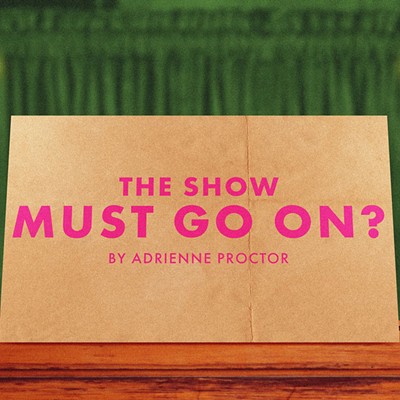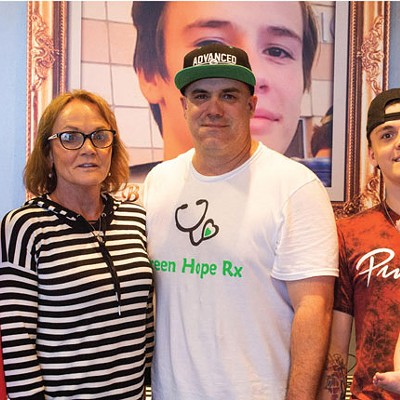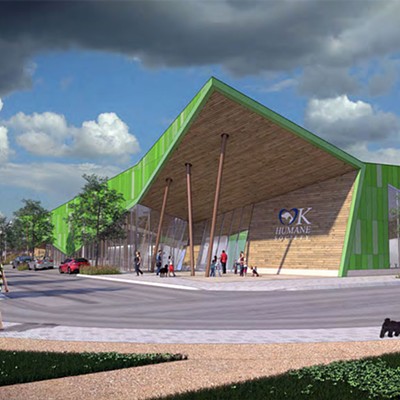
For John Steinbeck’s Joads, Oklahoma was a Dust Bowl nightmare they’d give up almost everything to escape. Rodgers and Hammerstein’s Oklahoma!, on the other hand, is always “doin’ fine.” To celebrate the 75th anniversary of the groundbreaking and blockbusting musical’s Broadway debut, Oklahoma History Center has a new exhibit titled Rodgers & Hammerstein’s Oklahoma!: The Birth of Modern Musical Theatre and a New Image for the State opening July 12.
“Before this musical, The Grapes of Wrath really dictated what people across the country thought about Oklahoma,” said Natalie Fiegel, the center’s lead curator, “that we were this poor, dirty, destitute place, that people were struggling and wanted to leave. And so Rodgers and Hammerstein’s Oklahoma! showing these hardy farmers that people could relate to, it was positive. It kind of brought a better picture for people of what Oklahoma was.”
The musical, which tells the story of a cowboy named Curly’s spirited courtship of farmer’s daughter Laurey, opened on Broadway in 1943 and marked the first collaboration between composer Richard Rodgers and lyricist Oscar Hammerstein, and a turning point in modern musical theater.
“This was the first time that the music and the plot and the characters, that everything fit into one story and it was all fully integrated,” Fiegel said. “Previously, theater and vaudeville, it was more entertainment-based. You’d have big musical productions and dance numbers, and then you’d have jokes. Everything kind of stood alone. It wasn’t necessarily a complete picture. Oklahoma! was the first time it was a full narrative where everything was related to each other. They actually thought it was going to be a dud because it was so different.”
Despite a producer’s legendary and possibly anecdotal dismissal of the musical as having “No gags, no gals, no chance,” because of its lack of comedians and chorus girls, Oklahoma! quickly became the biggest hit in Broadway history up to that point.
“Since then, things like West Side Story and Phantom of the Opera are about the same level, but up until Oklahoma! premiered in 1943, there had never been anything like it,” Fiegel said. “It was kind of the ’40s version of Hamilton. It really changed everything, and it was sold out for years. I mean, it was a big deal.”
Oklahoma! ran for more than 2,000 shows in five years. The musical’s success was partly due to its innovation, Lori Oden, the history center’s director of exhibits said, and partially because of its optimism in the midst of World War II.
“It was very uplifting and kind of gave people hope,” Oden said.
Stepping onstage
The history center’s 2,000 square-foot multimedia exhibit features audio-visual and interactive components. Fiegel said a replica of one of the musical’s sets near the entrance is designed to make visitors feel like they’re stepping onto the stage.
“We essentially re-created the opening scene that people are used to from Oklahoma!,” Fiegel said. “You walk into the exhibit and you see the farmhouse, and ‘Oh, What a Beautiful Morning’ starts playing, and there’s cornfield wallpaper.”
Oden said the center wanted to give visitors the impression that they’re in on the act. Dance steps placed on the floor diagram choreography from the original production.
“We tried to create an environment where you walk in and you feel like you’re a part of the musical,” Oden said. “It should be really neat, and I think it’s something that every Oklahoman or anybody who’s familiar with the play who’s seen it across the world will have a kind of familiarity to it and kind of a sentimentality about.”
A “backstage area” offers visitors a look at the amount of effort required to stage a production of Oklahoma! The exhibit also features one of Hammerstein’s writing desks alongside era-appropriate historical artifacts from the center’s collection to help put visitors in the mindset of the time when the musical was released. Though Oklahoma!’s depiction of its namesake is “not necessarily historically accurate and truthful,” Oden said, the musical and its response would prove to be historically significant for the Sooner State.
“It highlighted our state in a way that was positive for us,” Oden said. “Politicians were quick to embrace it.”
Gov. George Nigh signed legislation adopting the musical’s titular closing number as the state song in 1953, and Fiegel said people continue to associate Oklahoma with Hammerstein’s lyrics.
“If you travel, you’ll still get people that come up to you and say, ‘Oh, where the wind comes sweeping down the plain,’” Fiegel said.
State image
Oklahomans were also quick to embrace the version of the state the musical presented, even if it wasn’t completely accurate. When the first national tour came to the state in November of 1946, inclement weather prevented planned public celebrations of its arrival, but the musical still set attendance records and remained a popular touring production for nearly a decade straight.
“It had much more of an impact on Oklahoma in terms of image,” Fiegel said. “The plotlines and the characters obviously are not necessarily truthful, but then again, Rodgers and Hammerstein had never been to Oklahoma when they wrote it. All they knew about it was what Lynn Riggs, who was an Oklahoman, had written about it in Green Grow the Lilacs, which is what they based it on.”
Claremore native Riggs’ play offered a less cheerful, more ambiguous take on Indian Territory at the cusp of statehood. While Riggs’ characters, based on people he knew, were more specific to the state, Rodgers and Hammerstein’s version proved more popular, partially because of the songs.
“The music changed the tone of it and made it more general where audiences across the nation could relate to it as well as Oklahomans,” Fiegel said.
The movie adaptation of the musical, released in 1955, increased Oklahoma!’s popularity even further. Myriad Botanical Gardens will host a screening of the film, with closed captioning and sing-along titles, as the final movie in its Sonic Summer Movies series Aug. 1.
Recent productions of the play, as chronicled in the new exhibit, have featured more diversity among their casts, and a London-based production starring Hugh Jackman as Curly opened in 1999. To Oden, the reason for the musical’s continued popularity, in its namesake at least, is evident.
“Obviously, as Oklahomans,” she said, “we see it and we’re proud that there’s a musical Oklahoma! because other states don’t have musicals about them.”
The exhibit can be viewed 10 a.m.-5 p.m. Mondays-Saturdays at Oklahoma History Center, 800 Nazih Zuhdi Drive. Admission is free-$7. Call 405-521-2491 or visit okhistory.org.












